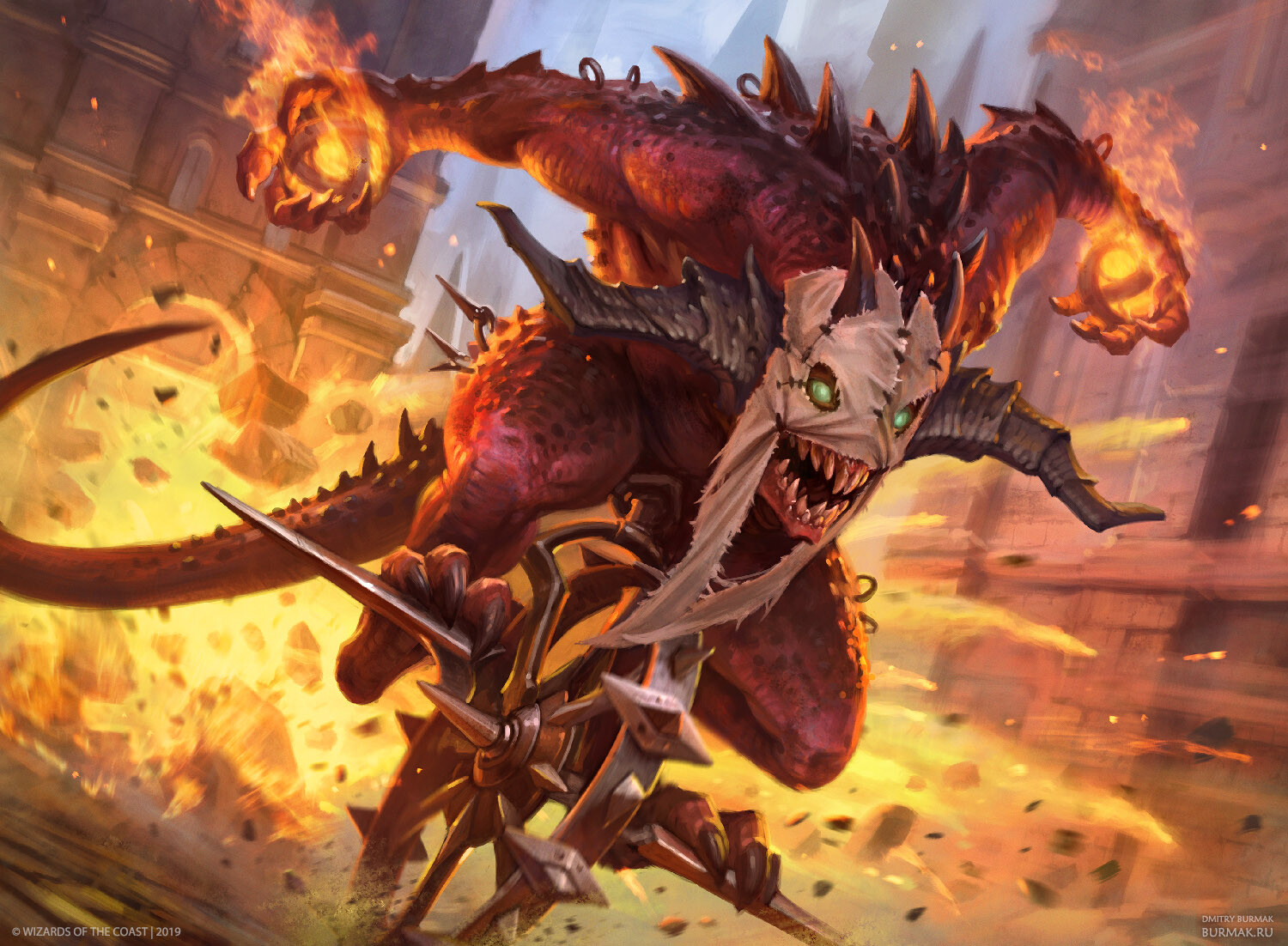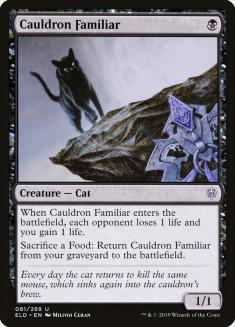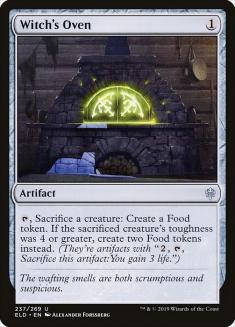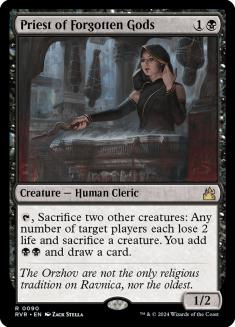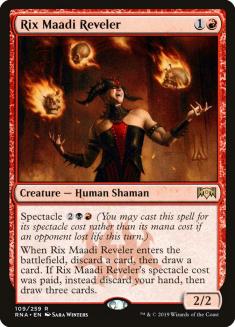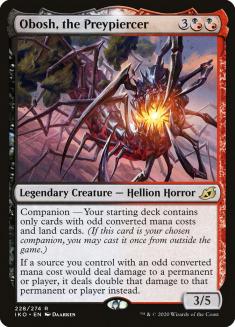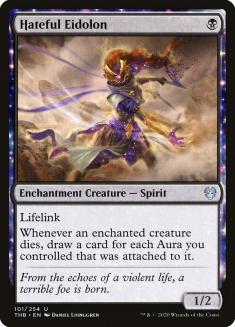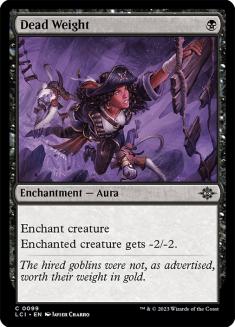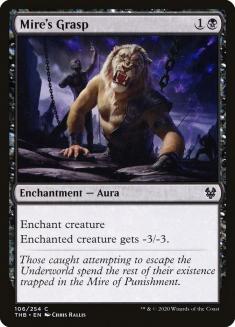With the release of Ikoria: Lair of Behemoths we have quite a few new tools to work with across all the formats. Everyone is going crazy over the power level and ubiquitous nature of these new companion creatures. The trouble with them is that there is no way to restrict them in Vintage, and many existing decks just get to play one of them for free. A few of the others are just powerful on their own, while others still are easy to build around and very much worth warping your deck to utilize. But one stands heads above the rest:
Lurrus of the Dream-Den is the best card ever made.
I don’t mean the best creature. I don’t mean the best card in Modern or Legacy or anything like that. Lurrus of the Dream-Den is better than Oko, Thief of Crowns. Lurrus of the Dream-Den is better than Ancestral Recall. Lurrus of the Dream-Den is better than any other Magic card ever created. Why?
It’s free.
“But Todd,” you might say, “how can a creature be better than Black Lotus? That’s just absurd.” The dynamic of an eighth card in hand at the start of every game is, frankly, a pretty ridiculous concept. We all know how brutal a mulligan can be, and the win percentage in any format drops significantly with a double or triple mulligan for conventional decks.
And that’s the thing. Lurrus of the Dream-Den as a creature, as a regular Magic card, is nothing overly special. It’s very good as a creature. If it was just a two- or three-of in my deck I’d be pretty happy about it because it punishes opponents for killing your creatures. It gives you something cool to do with Mishra’s Bauble in some formats. Lurrus of the Dream-Den is a solid threat with a great ability that gives you longevity and provides for some seriously interesting and cool gameplay.
But it should be banned in every format.
A few of the companions should be banned in every format. If I were a betting man I’d wager than three or more of them will be banned in every format (or something similar). But that’s not what I want to talk about today. I want to talk about Lurrus of the Dream-Den in the here and now, which is legal in every format.
It’s hard to describe exactly what a free eighth card means because we’ve never really had anything like it. Planeswalkers were similarly weird and ridiculous and powerful in the beginning, and things only cascaded a little out of control from there. But fair is fair, and those original five marquee characters were balanced. These ten companions are, on the whole, slightly too powerful but mostly still manageable.
I love the companion mechanic. It’s something I’ve seen in other games before, and I quite like always having a certain card or effect at your disposal and being able to build your deck around it. I especially like that these companion cards are creatures and not planeswalkers. In essence, you get an eighth card, but that eighth card doesn’t necessarily win the game on the spot. Lurrus of the Dream-Den is especially good here as it only costs three mana and has a particularly large impact on the game because of its ability to recur permanents that have been killed, countered, or discarded.
In Standard, I haven’t felt like any of the companions were overpowered. Good, powerful, and worth building around? Absolutely. But there’s a very steep cost to building around these cards, and I don’t know that any one of them is significantly better than the others. But Standard isn’t really the problem that anyone is talking about.
In the first week of a set being legal, I’ve never seen this kind of dominance across the spectrum of formats. But the scariest part of it all is that this is the first week. These decks aren’t tuned. They’re not in their final form. The rough drafts of these decks featuring and built around new cards are dominating. Just an incredible amount of consistency at your disposal here with the promise that slightly altering your deck configuration guarantees one whole extra resource.
Baffling.
But enough about that. I honestly love the companion mechanic. I just think the deckbuilding restrictions need to be a bit wackier or harder. I’ve had more fun playing Magic in the last week than I’ve had in a long time. Playing with powerful cards is not something we get to do often. It’s like the appeal of Treasure Cruise being legal in Pioneer. You know it’ll likely be a problem at some point, but it feels good down in your tingly when you spend one mana to draw three cards.
Standard hasn’t been a major focus of mine in quite some time, but these new cards have opened up some feelings. I played Standard all day in a PTQ, talked to some grinders about the format and their decks of choice, and came to some conclusions of my own after some seriously good and interactive games of Magic. It’s been a while since I’ve played a deck as complicated as Rakdos Sacrifice in Standard, and I don’t even know if my build is even close to correct!
Here’s everything I learned while playing Rakdos Sacrifice (and Lurrus) in Standard.
The New Rakdos Sacrifice
Rakdos Sacrifice, and variations of the archetype, have been around in Standard for a while. Older versions called “The Aristocrats” were some of the coolest and best decks in Standard’s past. This iteration features the sick one-two punch of Cauldron Familiar and Witch’s Oven.
You could definitely find worse cards to build your deck around. These two knuckleheads are great at preventing damage while slowly (but surely) draining your opponent of all their life points. It’s an annoyance that we’ve all come to love and loathe, depending on your affinity for the archetype.
The hook comes from moving away from the traditional three-drop creatures like Mayhem Devil in favor of meeting the companion requirements of Lurrus. In order to play Lurrus as your companion, you can’t play permanents that cost more than two mana. That means no Mayhem Devil or Woe Strider. No Midnight Reaper or Judith, the Scourge Diva. Instead, you always have access to Lurrus as an eighth card, and a potent weapon in this archetype.
Rebuying a Dead Weight or Mire’s Grasp makes other aggressive decks laughable, but the biggest thrill from playing Lurrus is that, if you untap with it, chances are your opponent can’t keep up with the card advantage gained. That means you need traditional removal to beat them, but traditional removal isn’t very good against the rest of your deck. All your creatures are “sticky,” or have two lives, which means killing them doesn’t really solve the problem.
After talking with Harlan Firer about the archetype this morning, here’s the list he suggested and I ended up playing in the PTQ to a 5-3 finish. I lost twice to a variant of the mirror, which we’ll be talking about in the second half of this article.
Creatures (24)
- 4 Rix Maadi Reveler
- 4 Priest of Forgotten Gods
- 4 Cauldron Familiar
- 4 Kroxa, Titan of Death's Hunger
- 4 Serrated Scorpion
- 4 Whisper Squad
Lands (23)
Spells (13)

For starters, losing Mayhem Devil is a huge deal. My first inkling was that maybe we should just play a normal version of this deck with two or three of them in the maindeck because it works so well in the archetype. Doing so would let you play the best three-drops in the business, giving you access to all those heavy hitters. However, having Lurrus as a companion is hard to quantify. It’s excellent. Your opponent basically has to save one removal spell for it or it will absolutely dominate the game. It gets even worse if you add stuff like Dead Weight or Mire’s Grasp to the equation.
But the best part of Lurrus, by far, is the fact that you can throw creatures around with abandon. Your only goal is to get the opponent dead, which means using Priest of Forgotten Gods aggressively. And that’s the rub: Priest of Forgotten Gods is absolutely bonkers with Lurrus. You get to cast it and the thing you sacrificed just by using the ability on Priest of Forgotten Gods. It also makes your opponent sacrifice a creature and allows you to draw a card!
Rix Maadi Reveler is a nice addition to the strategy, giving you a way to discard some of those graveyard related things early to bring them back later. It can give you a burst of cards when you run low on resources. It’s also another card that gets absolutely bonkers with an active Priest of Forgotten Gods.
Kroxa, Titan of Death’s Hunger was not that good for me. Sure, it did the thing Kroxa does, occasionally stealing the last card or two from the opponent and eventually threatening to deal the last few points if they aren’t careful. But pound for pound, slug for slug, I wish the deck was built differently and didn’t play the card.
The composition of this build is sleek, streamlined, and certainly one of the most powerful Standard decks I’ve ever played. It’s so hard to kill all the creatures and protect your life total without doing something completely and utterly bonkers. Stuff like Wilderness Reclamation is excellent against our deck because we don’t really interact in the “right” way and our threats don’t exactly hit hard and fast. With that said, you can still just get under them, and their deck is pretty weak when it misses land drops or doesn’t have some way to keep your graveyard in check.
While I think this deck is great, I also think there’s a better version already at our disposal, and it just plays a different companion!
Obosh, the Preypiercer forces you to play odds only, which means no two-drop and no Priest of Forgotten Gods. Instead, we get to play a five-mana card that turbos all of our cheap threats and allows us to make Mayhem Devil actually bonkers. Imagine dealing double damage with every sacrifice! That’s what Obosh brings to the table.
I played against multiple variations of this deck, and I have to say that the Obosh versions impressed me. I felt behind at all times, only winning in weird spots where I’d steal victory with a timely Claim the Firstborn or my opponent’s minor mistake would clap them on the swing back.
Obosh is very good, and the Rakdos Sacrifice deck doesn’t really care much about the two-mana cards. I already wanted to cut Kroxa, and the difference then becomes Priest of Forgotten Gods versus Mayhem Devil. Plus we get to play with two or three copies of Lurrus in our maindeck instead of having the one as your companion always die!
Ondrej Strasky was the first person I saw post about the deck, but word certainly travels quickly, as I played against the deck three times in the PTQ!
Mayhem Devil with Obosh is disgusting, but the thing I like most about this deck is that it can be aggressive when it needs to be. Gutterbones and Knight of the Ebon Legion provide some nice pressure in the early turns and do some serious damage when combined with Obosh later on. Gutterbones also has natural recursion, which makes removal a bit worse than it would normally be against an aggressively slanted deck.
I like the Woe Strider package, but I’m not sold on the full four. I’d like to move some of these numbers around in general, but Ondrej seems to like the list fine enough. If this archetype is your jam, definitely follow him to keep updated. But there’s one last thing I wanted to touch on before we move on.
What if we put a huge emphasis on the removal recursion?
In the first match I played with the Rakdos deck, my opponent performed a neat little combo that I just didn’t realize was a thing. Hateful Eidolon plus either Dead Weight or Mire’s Grasp kills your opponent’s creature and draws a card. I don’t know exactly how to implement it into either of these builds, but I do know that Serrated Scorpion was sideboarded out a lot. I don’t know that cutting it is correct exactly, but they feel like they’d occupy the same space. That slot is just a body, and Serrated Scorpion is the best body for the job currently. But that doesn’t mean piling in some Dead Weights and such alongside Hateful Eidolon won’t be significantly better. If the mirror becomes ultra-popular, that combo can give you enough juice to fight through the raw card advantage that is Lurrus of the Dream-Den.
In previous Standard formats, removal was pretty good. I can’t say the same about the past year or so, because the emphasis seems to have been on going outrageously over the top of your opponent. Wilderness Reclamation and Fires of Invention and a swath of planeswalkers meant stuff like Doom Blade just didn’t hit the same. Now it seems creatures are starting to become a bit more important, which means it might be time to move back to a bit more “traditional” deckbuilding.
Here’s where I’d like to start:
Creatures (22)
- 3 Gutterbones
- 4 Mayhem Devil
- 4 Knight of the Ebon Legion
- 4 Cauldron Familiar
- 3 Woe Strider
- 2 Hateful Eidolon
- 2 Lurrus of the Dream-Den
Lands (25)
Spells (13)
Sideboard

The addition of Hateful Eidolon is a concept from the Lurrus Orzhov Auras decks we’ve seen in the first week, but one that I’m excited to try out in a deck that doesn’t play a lot of Auras. It might be better in the Lurrus version of Rakdos Sacrifice, since you can play both Dead Weight and Mire’s Blight, or it might not belong at all. I’ve liked all of the one-mana creatures in different scenarios. Even Whisper Squad performed in some spots, including when we just needed bodies to toss away to Priest of Forgotten Gods.
Overall, I think losing Mayhem Devil is a bit too large a price to pay, and especially so for the mirror. Mayhem Devil will singlehandedly make or break a game, as I saw time and time again from the business end of one. I really like both versions, but I think the one I’d definitely lean toward is Obosh over Lurrus because the deckbuilding restriction doesn’t seem quite as steep.
While the companion cards might not be long for older formats, they’re almost all going to be around for the duration of Standard. The games I’ve played so far have been quite enjoyable, and I find they make for exciting content to boot. I’m sure they’ll get old soon, but for now I’m having a blast.
If companion becomes a real problem in the near future, it might behoove Wizards of the Coast (WotC) to examine a re-work of the companion mechanic entirely. Being a free eighth card is the most ridiculous part of the whole thing. What would be so wrong with it being a part of your seven-card opening hand? After all, creating another “exile zone” or “AFK zone” is pretty messy, and the companion mechanic on the card doesn’t explicitly say what it does. They could just make it do whatever they wanted, just so long as you meet the companion cost. It’s an interesting problem to tackle for sure, but I can safely say that the gameplay has been phenomenal, even if we’re all resorting to the same gimmicks.
Are these companion cards too good? Yeah, probably, but I’m sure going to enjoy the next few weeks of gameplay before any drastic measures are taken! If you like Rakdos Sacrifice, make sure to give both versions a try and figure out the one you like best yourself. The deckbuilding restrictions make it pretty interesting, and I quite like that it’s not exactly clear which one you should choose! But it is pretty clear that you should choose one.

